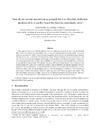Please use this identifier to cite or link to this item:
https://accedacris.ulpgc.es/jspui/handle/10553/46941
| Title: | Two-dimensional numerical approach for the vibration isolation analysis of thin walled wave barriers in poroelastic soils | Other Titles: | Enfoque numérico bidimensional para el análisis de aislamiento de vibraciones de barreras de onda de pared delgada en suelos poroelásticos | Authors: | Rodríguez Bordón, Jacob David Aznárez González, Juan José Maeso Fortuny, Orlando Francisco |
UNESCO Clasification: | 330510 Cimientos 2201 Acústica 120601 Construcción de algoritmos 3305 Tecnología de la construcción |
Keywords: | Dual boundary element method BEM-FEM Rayleigh waves Soils Vibration analysis, et al |
Issue Date: | 2016 | Publisher: | 0266-352X | Journal: | Computers and Geotechnics | Abstract: | This paper is concerned with the vibration isolation efficiency analysis of total or partially buried thin walled wave barriers in poroelastic soils. A two-dimensional time harmonic model that treats soils and structures in a direct way by combining appropriately the conventional Boundary Element Method (BEM), the Dual BEM (DBEM) and the Finite Element Method (FEM) is developed to this aim. The wave barriers are impinged by Rayleigh waves obtained fromBiot’s poroelasticity equations assuming a permeable free-surface. The suitability of the proposed model is justified by comparison with available previous results. The vibration isolation efficiency of three kinds ofwave barriers (open trench, simple wall, open trench-wall) in poroelastic soils is studied by varying their geometry, the soil properties and the frequency. It is found that the efficiency of these wave barriers behaves similarly to these in elastic soils, except for high porosities and small dissipation coefficients. The efficiency of open trench-wall barriers can be evaluated neglecting their walls if they are typical sheet piles. This does not happen with walls of bigger cross-sections, leading in general to efficiency losses. Likewise, increasing the burial depth to trench depth ratio has a negative impact on the efficiency. | URI: | https://accedacris.ulpgc.es/handle/10553/16342 | ISSN: | 0266-352X | DOI: | 10.1016/j.compgeo.2015.08.007 | Source: | Computers and Geotechnics [ISSN 0266-352X], v. 71, p. 168-179 | Rights: | by-nc-nd |
| Appears in Collections: | Artículos |
SCOPUSTM
Citations
22
checked on Jun 8, 2025
WEB OF SCIENCETM
Citations
18
checked on Jun 8, 2025
Page view(s)
68
checked on Aug 24, 2024
Download(s)
58
checked on Aug 24, 2024
Google ScholarTM
Check
Altmetric
Share
Export metadata
Items in accedaCRIS are protected by copyright, with all rights reserved, unless otherwise indicated.
